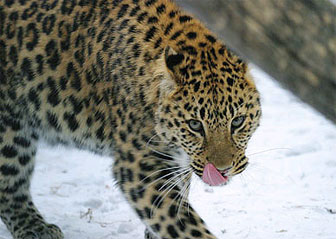Less than 35 Amur leopard remain in the wild
Less than 35 Amur leopard remain in the wild
mongabay.com
April 19, 2007
A new census shows the world’s most endangered cat, the Amur or Far Eastern leopard (Panthera pardus orientalis), is on the brink of extinction with a wild population estimated at 25-34 individuals.
“The recent census confirmed once again that the Amur leopard survives on very shaky ground,” said Pavel Fomenko, biodiversity conservation program coordinator at the Far-Eastern branch of WWF in Russia.
Fomenko said development pressures, new roads, poaching, exploitation of forests, and climate change are driving the Amur leopard towards extinction, but that conservation efforts could save the species.
“From my perspective, the leopards’ exact number is not the big question. What is really important is that the predator is on the brink of extinction. And still a unified protected area with national park status has not been established, which is the most important thing for the leopards’ survival.”

Photo courtesy of WWF |
Dr. Dmitry Pikunov, the coordinator of the 2007 leopard census and head of the laboratory of animal ecology and conservation of the Pacific Institute of Geography of the Russian Academy of Science says that an adult male leopard needs 500 square kilometers of habitat with good forests and stable prey populations.
“Maybe this is the reason why leopards practically completely disappeared from the Korean Peninsula and north-east China,” said Dr. Pikunov. “At the beginning of the past century, the Far Eastern leopard was a common species in the southern parts of Sikhote-Alin and in some Khanka lake areas. Right now it roams only in south-west Primorye.”
The good news from the census, which was conducted by World Wildlife Fund, the Wildlife Conservation Society, and the Pacific Institute of Geography of the Russian Academy of Science, is that Amur leopard populations appear to be increasing: the 2000 census listed a range or 22-28 animals, the 2003 census showed 28-30 animals, and the 2007 census estimated 25-34 animals.
Related articles
– this report used quotes and information from WWF







